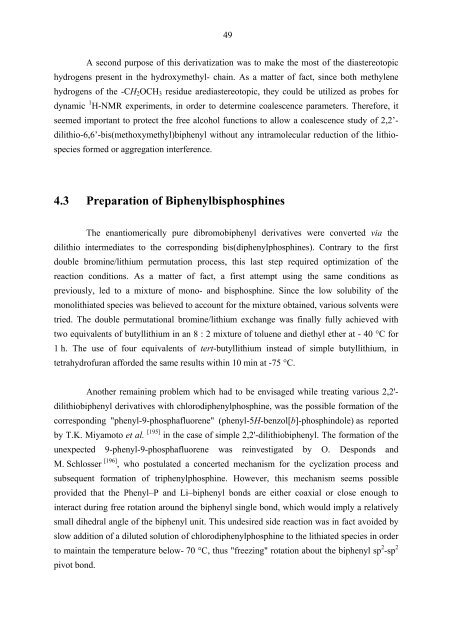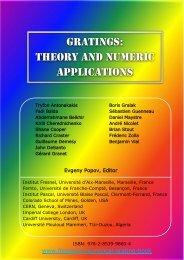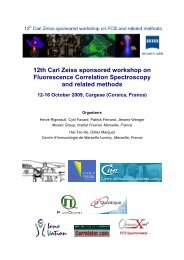My PhD dissertation - Institut Fresnel
My PhD dissertation - Institut Fresnel
My PhD dissertation - Institut Fresnel
You also want an ePaper? Increase the reach of your titles
YUMPU automatically turns print PDFs into web optimized ePapers that Google loves.
49<br />
A second purpose of this derivatization was to make the most of the diastereotopic<br />
hydrogens present in the hydroxymethyl- chain. As a matter of fact, since both methylene<br />
hydrogens of the -CH2OCH3 residue arediastereotopic, they could be utilized as probes for<br />
dynamic 1 H-NMR experiments, in order to determine coalescence parameters. Therefore, it<br />
seemed important to protect the free alcohol functions to allow a coalescence study of 2,2’-<br />
dilithio-6,6’-bis(methoxymethyl)biphenyl without any intramolecular reduction of the lithio-<br />
species formed or aggregation interference.<br />
4.3 Preparation of Biphenylbisphosphines<br />
The enantiomerically pure dibromobiphenyl derivatives were converted via the<br />
dilithio intermediates to the corresponding bis(diphenylphosphines). Contrary to the first<br />
double bromine/lithium permutation process, this last step required optimization of the<br />
reaction conditions. As a matter of fact, a first attempt using the same conditions as<br />
previously, led to a mixture of mono- and bisphosphine. Since the low solubility of the<br />
monolithiated species was believed to account for the mixture obtained, various solvents were<br />
tried. The double permutational bromine/lithium exchange was finally fully achieved with<br />
two equivalents of butyllithium in an 8 : 2 mixture of toluene and diethyl ether at - 40 °C for<br />
1 h. The use of four equivalents of tert-butyllithium instead of simple butyllithium, in<br />
tetrahydrofuran afforded the same results within 10 min at -75 °C.<br />
Another remaining problem which had to be envisaged while treating various 2,2'dilithiobiphenyl<br />
derivatives with chlorodiphenylphosphine, was the possible formation of the<br />
corresponding "phenyl-9-phosphafluorene" (phenyl-5H-benzol[b]-phosphindole) as reported<br />
[ ]<br />
by T.K. Miyamoto et al. 195 in the case of simple 2,2'-dilithiobiphenyl. The formation of the<br />
unexpected 9-phenyl-9-phosphafluorene was reinvestigated by O. Desponds and<br />
[ ]<br />
M. Schlosser 196 , who postulated a concerted mechanism for the cyclization process and<br />
subsequent formation of triphenylphosphine. However, this mechanism seems possible<br />
provided that the Phenyl–P and Li–biphenyl bonds are either coaxial or close enough to<br />
interact during free rotation around the biphenyl single bond, which would imply a relatively<br />
small dihedral angle of the biphenyl unit. This undesired side reaction was in fact avoided by<br />
slow addition of a diluted solution of chlorodiphenylphosphine to the lithiated species in order<br />
to maintain the temperature below- 70 °C, thus "freezing" rotation about the biphenyl sp 2 -sp 2<br />
pivot bond.













